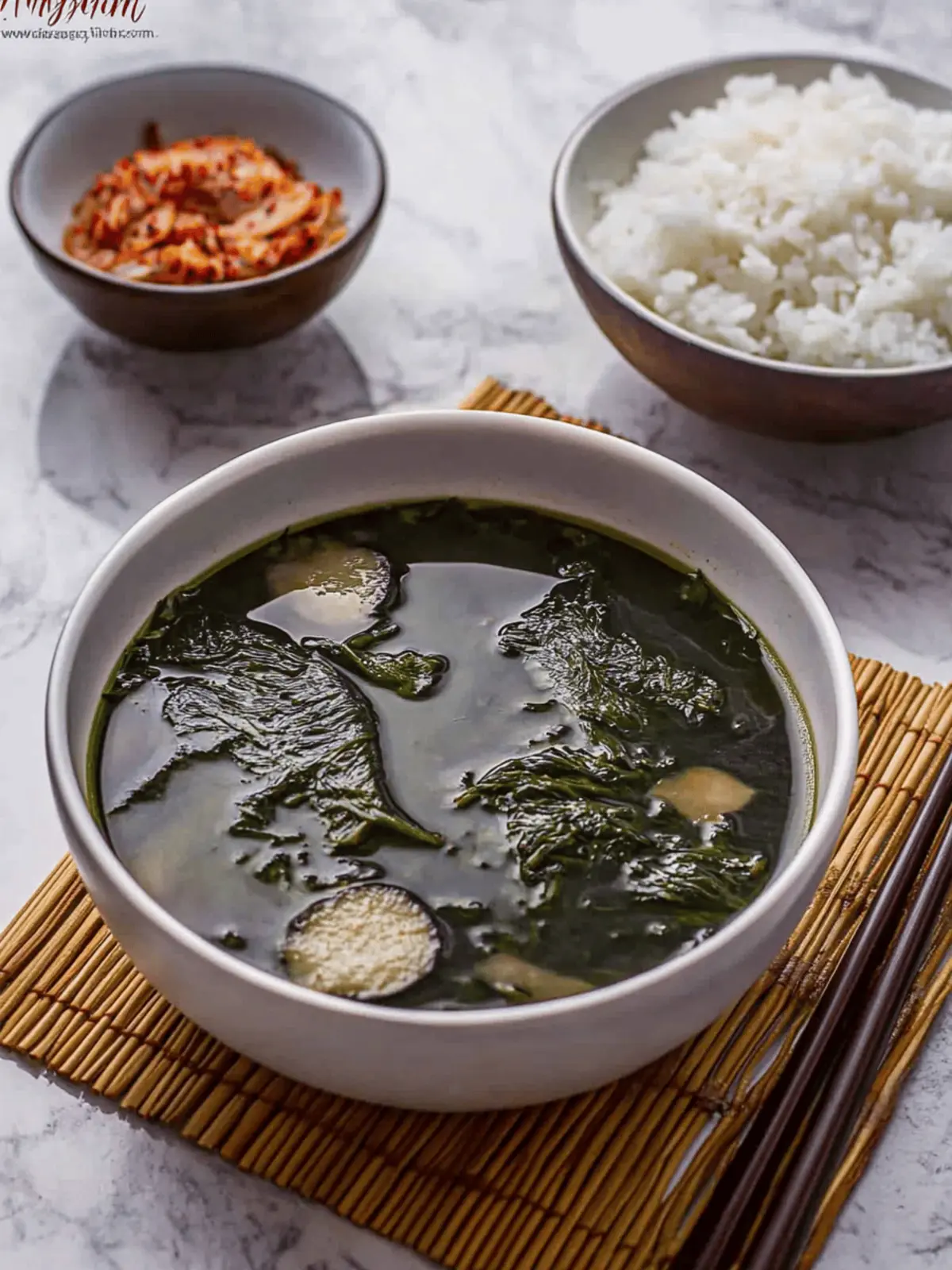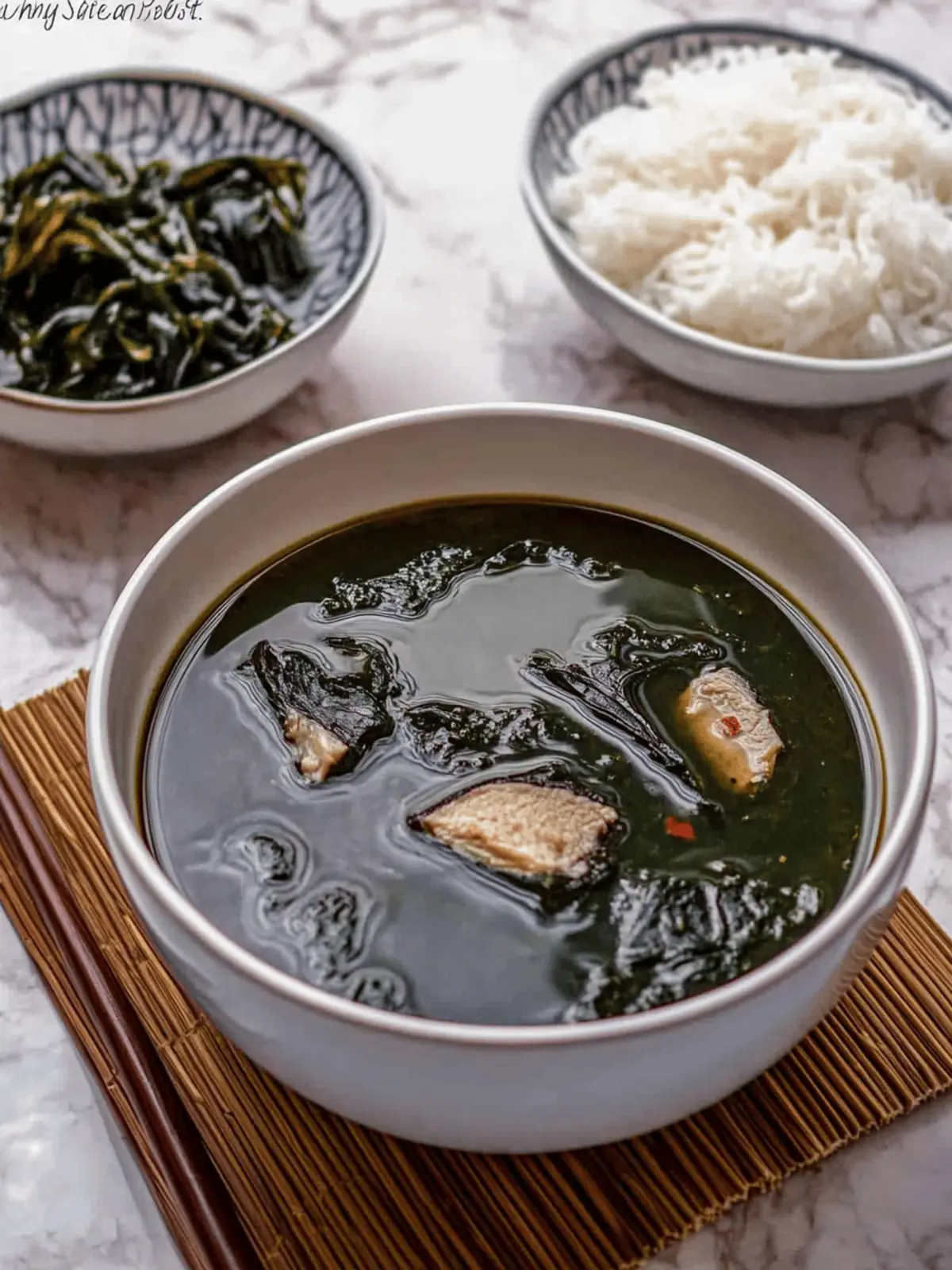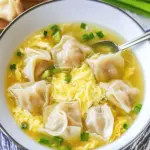There’s a certain comfort that comes with a warm bowl of soup, especially when it transports you to a cozy kitchen filled with rich aromas. One of my all-time favorites is Miyeokguk – Korean Seaweed Soup. This dish not only warms the soul but is also packed with earthy flavors and nourishing ingredients. I first embraced this recipe during one of those chilly evenings when I craved something wholesome and hearty.
As the soothing scent of sesame oil and garlic mingled in the air, I realized that this traditional soup is perfect for everyone—from busy professionals looking to break free from fast food to home chefs eager to impress guests with a simple yet flavorful dish. With just a handful of ingredients, you can create a meal that speaks volumes of love and care.
Join me as I share this delightful recipe and discover how easy it is to whip up a comforting bowl of Miyeokguk that’s not only satisfying but also bursting with rich cultural heritage. Get ready to elevate your cooking repertoire!
Why is Miyeokguk so special?
Comforting warmth radiates from every bowl of Miyeokguk, making it the ultimate soul food. Nutritious benefits of the nutrient-rich seaweed combined with tender beef create a dish that’s both healthy and delicious. Quick preparation means you can savor a homemade meal in just 45 minutes, perfect for busy nights. Versatile pairing options with rice and kimchi can satisfy any craving. Plus, this dish promises to impress guests while being immensely satisfying. For more delightful soup recipes, check out my cozy soup collection.
Ingredients for Miyeokguk
For the Soup
- 10 g Dried Seaweed – this key ingredient not only adds depth but also brings numerous health benefits.
- 100 g Beef plate/brisket – tender cuts enhance the soup’s richness and create a hearty base.
- 2 tbsp Sesame Oil – infuses a nutty flavor; adjust to taste for that toasty aroma.
- 3 tbsp Soy Sauce – adds umami and depth to the broth; choose low-sodium for a lighter option.
- 7 cups Water – the foundation of your soup—use homemade stock for extra flavor!
- 3 cloves Garlic, minced – brings a fragrant kick; the more garlic, the better for flavor!
- 1 tbsp Fish Sauce – elevates the dish with a savory essence; be cautious, a little goes a long way.
How to Make Miyeokguk
-
Soak the dried seaweed in a bowl of water until it blooms, about 20 minutes. Afterward, drain and chop it into bite-sized pieces, setting it aside for the soup.
-
Slice the beef into thin, bite-sized pieces. In a pot, heat the sesame oil over medium heat and stir-fry the beef until it’s beautifully browned—this should take about 5-7 minutes.
-
Combine the seaweed and soy sauce with the beef in the pot, stir-frying for about a minute to let those flavors mingle. Then, add the water to the mixture.
-
Boil the soup until it starts bubbling, and then stir in the minced garlic and fish sauce. Let it simmer for about 15 minutes or until the beef is tender and the aroma fills your kitchen.
-
Serve the Miyeokguk hot, alongside warm rice and kimchi. Dive in and enjoy every soulful spoonful!
Optional: A sprinkle of sesame seeds on top adds a delightful crunch.
Exact quantities are listed in the recipe card below.

How to Store and Freeze Miyeokguk
Fridge: Store leftover Miyeokguk in an airtight container for up to 3 days. Reheat gently on the stove over low heat, adding a splash of water for moisture if needed.
Freezer: Miyeokguk can be frozen for up to 2 months. Ensure it cools completely before transferring to a freezer-safe container. Defrost in the fridge overnight before reheating.
Storage Tips: Avoid storing the soup with rice mixed in, as it can turn mushy when frozen. Instead, keep them separate for the best texture when reheating.
Reheating: To enjoy your Miyeokguk again, use the stovetop for a more even heat distribution and to maintain its comforting flavors.
Expert Tips for Miyeokguk
• Soaking Seaweed: Make sure to soak the dried seaweed long enough to bloom properly; this enhances its texture in the soup.
• Cut Beef Thinly: For the best results, slice the beef against the grain into thin pieces; this ensures tender bites in your Miyeokguk.
• Season Gradually: When adding soy sauce and fish sauce, do so gradually and taste as you go; it’s easy to oversalt, especially with the fish sauce!
• Let It Simmer: Allow the soup to simmer at a gentle boil; this helps meld the flavors beautifully and tenderizes the beef perfectly.
• Serve Fresh: Enjoy your Miyeokguk right after cooking for the best flavor and aroma; it’s a dish that tastes best when freshly made!
Make Ahead Options
Preparing Miyeokguk ahead of time is a game changer for busy weeknights! You can soak and chop the dried seaweed up to 24 hours in advance and store it in an airtight container in the refrigerator to keep it fresh. Additionally, you can slice the beef and marinate it with the soy sauce and sesame oil up to 3 days before cooking, ensuring those flavors deepen. When you’re ready to enjoy your comforting soup, simply heat the sesame oil in a pot, stir-fry the prepped beef until browned, then add the seaweed and water. This way, you’ll savor a delicious bowl of Miyeokguk with minimal effort, proving that homemade meals can fit seamlessly into your busy lifestyle!
What to Serve with Miyeokguk?
Warm bowls of Miyeokguk invite wholesome sides that elevate this flavorful soup to a complete meal.
-
Steamed White Rice:
A staple in Korean cuisine, rice soaks up the savory broth beautifully, making each spoonful even more satisfying. -
Spicy Kimchi:
The tangy crunch of kimchi offers a delightful contrast, enhancing the soup’s flavors while adding a burst of heat. -
Sesame Spinach Salad:
Lightly dressed in sesame oil, this fresh salad adds a vibrant, nutritious element to your meal. It’s healthy, refreshing, and perfect for balancing the hearty soup. -
Pickled Vegetables:
Offering a zesty crunch, these tangy bites provide a burst of flavor that keeps your taste buds engaged with every taste of the Miyeokguk. -
Fried Tofu:
Soft, airy, and mildly flavored, fried tofu pairs wonderfully, soaking up the essence of the soup for a soul-soothing experience. -
Savory Korean Pancakes (Jeon):
Crispy on the outside and fluffy inside, these pancakes bring additional texture and heartiness alongside the delicate soup. -
Cold Barley Tea:
This refreshing drink cleanses the palate, subtly complementing the rich flavors of the soup and enhancing the dining experience. -
Sweet Red Bean Dessert:
To finish with a hint of sweetness, this traditional dessert provides a delightful end to a comforting meal, marrying flavors beautifully with your soup.
Miyeokguk Variations & Substitutions
Feel free to explore these delightful twists on your Miyeokguk that will elevate your soup experience!
- Vegetarian: Swap out beef for mushrooms like shiitake, adding depth and umami to your broth.
- Seafood Delight: Incorporate scallops or shrimp for a taste of the ocean, bringing a whole new dimension to the soup.
- Spicy Kick: Add a teaspoon of gochugaru (Korean red pepper flakes) for a gentle heat that warms the soul.
- Flavor Boost: Toss in a tablespoon of miso paste while simmering, enriching the soup with a savory richness.
- Coconut Cream: For a tropical twist, stir in a splash of coconut cream, creating a creamy and exotic profile.
- Noodle Addition: Amp up the substance by throwing in some udon or soba noodles, making it a more filling dish.
- Herb Infusion: Fresh cilantro or green onions as a garnish add brightness and elevate the overall flavor.
- Gluten-Free: Substitute soy sauce with tamari to enjoy a gluten-free version while keeping the essence intact.
Feel free to mix and match these suggestions; after all, cooking is about creativity and personal touch!

Miyeokguk – Korean Seaweed Soup Recipe FAQs
What type of seaweed should I use for Miyeokguk?
Absolutely! For Miyeokguk, the ideal choice is dried wakame seaweed, which blooms beautifully and adds the right texture. Look for thin, dark green strips, free from any dark spots. If you’re unsure, feel free to ask at your local Asian market!
How long can I store Miyeokguk in the refrigerator?
You can store your leftover Miyeokguk in an airtight container for up to 3 days. Just reheat gently over low heat on the stove, and I recommend adding a splash of water to restore some moisture—no one likes dry soup!
Can Miyeokguk be frozen?
Yes, you can freeze Miyeokguk and enjoy it later! Be sure to let the soup cool completely before transferring it to a freezer-safe container. It should stay good for up to 2 months. For the best texture, I suggest keeping the rice separate—this way, it won’t turn mushy when reheated.
What should I do if my Miyeokguk is too salty?
Very! If you find yourself with a salty Miyeokguk, don’t worry—it happens to the best of us. You can balance the saltiness by adding more water or unsalted stock to dilute the flavors. A sprinkle of sugar can also help to counteract excessive salt. Simmer the soup for additional time and taste as you go!
Are there any dietary restrictions I should be aware of?
Absolutely! If you’re cooking for someone with allergies, take note of the fish sauce and soy sauce—they often contain gluten and fish ingredients. You can substitute with gluten-free soy sauce or tamari and consider using coconut aminos as a fish sauce alternative for a lovely savory flavor.
How can I enhance the flavor of Miyeokguk?
For an even more delightful Miyeokguk, consider adding thinly sliced mushrooms or a splash of rice wine while it simmers. You might also want to toss in some sliced green onions right before serving for a fresh touch! Enjoy being creative with your flavors; the more, the merrier!

Nourish Your Soul with Miyeokguk – Korean Seaweed Soup Recipe
Ingredients
Equipment
Method
- Soak the dried seaweed in a bowl of water until it blooms, about 20 minutes. Afterward, drain and chop it into bite-sized pieces, setting it aside for the soup.
- Slice the beef into thin, bite-sized pieces. In a pot, heat the sesame oil over medium heat and stir-fry the beef until it’s beautifully browned—this should take about 5-7 minutes.
- Combine the seaweed and soy sauce with the beef in the pot, stir-frying for about a minute to let those flavors mingle. Then, add the water to the mixture.
- Boil the soup until it starts bubbling, and then stir in the minced garlic and fish sauce. Let it simmer for about 15 minutes or until the beef is tender and the aroma fills your kitchen.
- Serve the Miyeokguk hot, alongside warm rice and kimchi. Dive in and enjoy every soulful spoonful!






